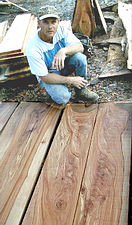Question
We started our new 7 23LucasMill for the first time yesterday and had a fantastic time. Having never seen a log being milled before, we were seriously impressed with its capabilities. Can someone please guide me to some online literature/films on how to go about planning the best cuts to be made?
I understand the basic theory behind quarter and plain sawing but actually applying that in reality to a lumber that isn't perfectly round, etc - is there a science to it? Yesterday we just played but I can see there is some art to getting the most out of the wood you have on the mill. Detailed and broad info would be good. We have lots of different type of wood to be milled and need timber for plenty of different jobs. I'm sure the best thing is to go out and get milling and learn on the job but any pointers would be greatly appreciated.
Forum Responses
(Sawing and Drying Forum)
From contributor M:
In addition to research and reading it would help you to visit as many mills as you can and talk with the sawyer while he is cutting. No better way to learn.
A swingmill, mostly cut the log from one stationary position. That position is often "as is" or "as loaded". You can certainly read the literature and find out about how to read the outside of a log and picking the best side; assuming you can get that side setup on you mill. To my knowledge there isn't a swingmill how to book. But you may find techniques discussed on various forums.
Here is what I try and do with my 8 1/2" swingmill:
1. Plan for the majority of the cuts to be be around 6" deep.
2. Use the vertical cut as the primary cut.
3. Whenever possible, make a deep horizontal cut and then several vertical cuts in both directions making a board on each pass; in other word minimize the number of passes.
4. Try to always finish a board with the vertical cut so the board weight will not pinch the saw.
5. Pay attention and learn feed speeds versus cut depth range.
As to special safety considerations:
1. Do not turn your back on the mill.
2. Push the horizontal cut.
3. Keep the area clean and clear of trip points.
4. Keep folks (off bearer) away from the front of the saw.
Any of my recommendation are superseded by the manufactures of your mill. I own a Brand X mill and it has different recommendations than a Lucas.
